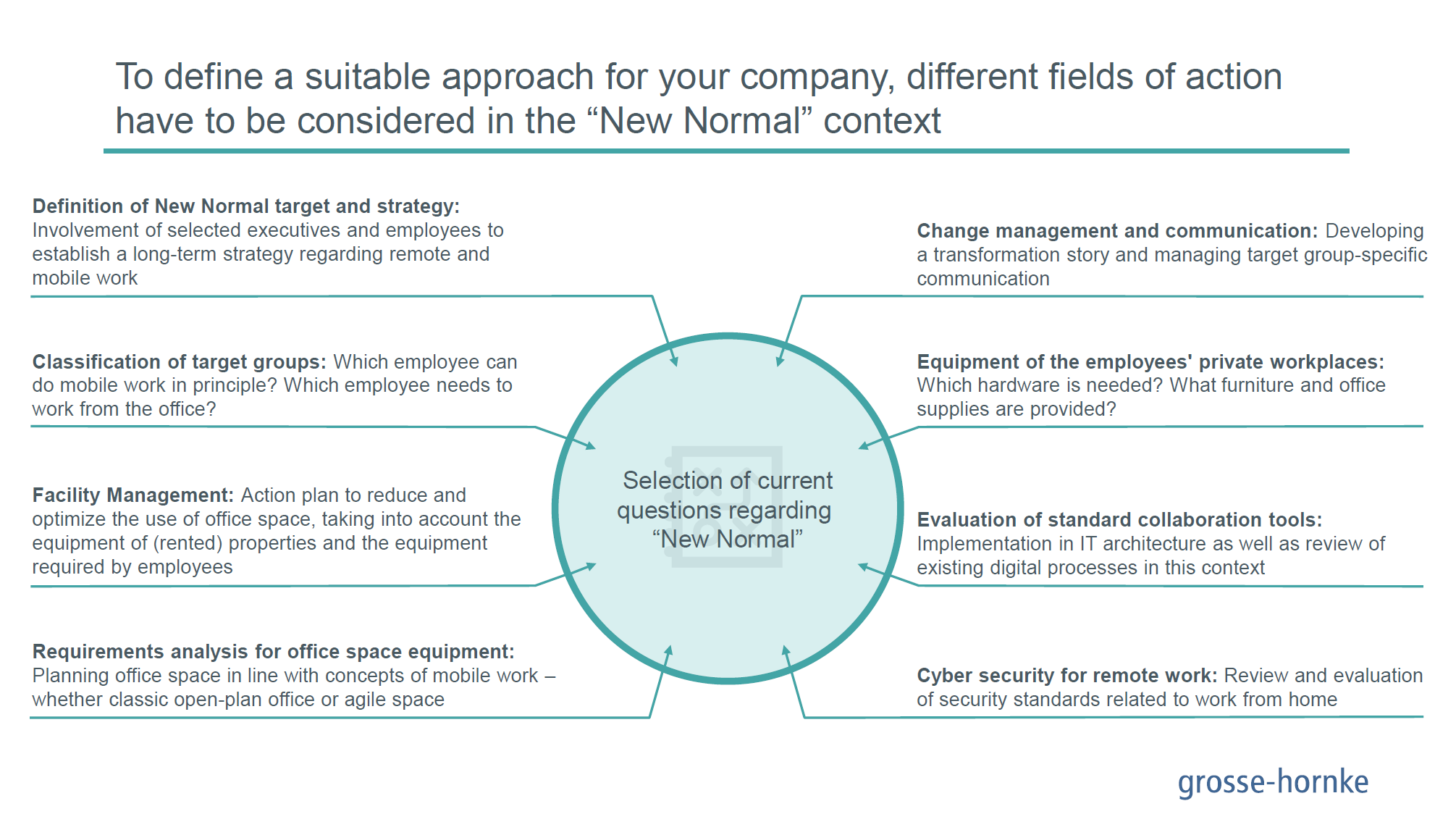
Leading in times of crisis: How healthy optimism works
Crises are as much a part of business as stormy weather at sea. But what if the storm lasts longer? 3 impulses for strong leadership in a crisis.

What will office life look like after the pandemic? Employees are seeking more flexibility, while companies are rethinking their interior concepts. Managers and operational teams should work together to determine their path to the New Normal, establishing clear rules.
The five-day office week seems to be a phase-out model. Many renowned companies have already announced that they won’t return to their former office routine after the pandemic. Porsche, for example, allows white collar employees up to twelve remote working days, six times as many as before. Siemens has reached a company agreement providing for up to three mobile working days per week. Deutsche Telekom permits employees to switch between the office and remote work, depending on the task at hand: activities that require a high level of concentration can be done at home, while creative tasks may work better on site as part of a team. Even the digital pioneer Amazon wants to return to an “office-centric culture”, highlighting the fact that virtual collaboration is only a temporary solution.
During the Corona crisis, companies were able to explore the strengths and weaknesses of mobile work. It turned out to be much more productive than expected. Employees could familiarize themselves with virtual teamwork and learned to appreciate a more flexible time schedule. Many of them don’t want to return to daily commuting. Over the past year and a half, professionals have developed new preferences that companies need to deal with: General rejections of remote work are no longer justified. Moreover, in terms of operating costs, traditional onsite work doesn’t appear to be very rational, either. With new hybrid work models, many companies could permanently reduce their expenses for office space.
The New Normal is intended to combine both: Employers want to remain attractive to skilled workers, while at the same time they are downsizing and thus making themselves fit for future competition. The necessary changes can be very profound, regarding the following aspects:
The following months will be a period of transition that companies can use for thoughtful transformation.

The shift is particularly challenging where companies are transforming both the nature of collaboration and their workspaces. In terms of day-to-day collaboration, a hybrid model is significantly more complex than face-to-face work. Phone calls, chats and video conferencing are replacing in-person contact. However, they don’t create a feeling of belonging. In order to build trust, leaders need other means. Managers and employees should take time to reflect together on the future work culture and establish new rules for everyday life that everyone can accept. This may include redefining criteria for careers within the company: People who frequently work from home shouldn’t feel deprived.
In combination with hybrid work, a modern interior concept such as “Dynamic Spaces” can do very well. This involves turning the office into an interaction area. Employees don’t have personal seats, but share a so-called home base with colleagues who are collaborating. Within this space, each person chooses his or her desk on a daily basis. Employees can, e.g., network across disciplines and work closer together, on a project-by-project basis. It’s up to the company to determine what each home base should look like: Which employees are assigned to it, and what are the tasks they perform on site? Is the office composed of many permanent workstations or is it mainly meeting rooms?
Based on interviews, internal surveys, focus groups and workshops, top management can figure out what executives and employees are expecting. Should hybrid work, e.g., go along with lower hierarchies and more personal responsibility for employees? Function by function, it has to be examined which occupational groups can work remotely in general, what equipment they need, and how many office workplaces will be necessary in the future. Once the goals have been set, the transformation is rolled out: with a convincing story, targeted measures that reduce potential fears and resistance, guiding all stakeholders on their path to the New Normal.

Crises are as much a part of business as stormy weather at sea. But what if the storm lasts longer? 3 impulses for strong leadership in a crisis.

He conveyed confidence in a desperate situation: British polar explorer Ernest Shackleton and his team survived a two-year battle for survival in the Southern Ocean. What can leaders learn from him in times of crisis?

Getting an IT project across hundreds of organizational units to the finish line? Our colleague Mathis takes a sporty approach. In our interview, he tells us what excites him about project management as a consultant and why he goes to the boxing ring to compensate.
2021 Grosse-Hornke